Summer is here, and that means many families are taking to the road. Road trips are a fantastic way to see America and spend quality time with friends are family. Because you’ll be spending a lot of time in your car, staying comfortable during your summer road trip is essential. Here are our top tips to help you stay cozy during your cross-country drive.
Top Tips for Staying Comfortable During Your Summer Road Trip
1. Wear loose, comfortable clothes
While it’s tempting to want to look stylish the moment you arrive at your destination, it’s important to wear loose and comfortable clothes on a long drive. This type of clothing not only improves your comfort, it helps keep your blood circulation normal too.
2. Consider your footwear
 This tip ultimately comes down to a personal preference. Slip-ons and sandals are ideal for long drives, but some people live in their sneakers. Whatever your footwear of choice might be, you’ll ideally want to avoid shoes that constrict or cut into your skin to help make your drive as comfortable as possible.
This tip ultimately comes down to a personal preference. Slip-ons and sandals are ideal for long drives, but some people live in their sneakers. Whatever your footwear of choice might be, you’ll ideally want to avoid shoes that constrict or cut into your skin to help make your drive as comfortable as possible.
3. Adjust your seat
Seat placement is essential for long-term drives. A seat that is too close to the wheel can cause leg cramps and discomfort. A seat that is too far away can cause arm and neck strain. In both cases, you may find yourself fatigued due to the excess strain.
Grab a seat cushion if you need one to improve your seat placement. Consider a lumbar support bar if you have back trouble.
4. Keep snacks and other trip essentials within reach
 By keeping snacks and other trip essentials within reach, you’ll save yourself a lot of hassle when, two hours into your trip, you realize that you need a charging cable for your phone or GPS.
By keeping snacks and other trip essentials within reach, you’ll save yourself a lot of hassle when, two hours into your trip, you realize that you need a charging cable for your phone or GPS.
Trip essentials to keep within reach include:
- Snacks
- Water
- Entertainment (mp3 players, music)
- Charging cables
- Maps
5. Stay hydrated
Staying comfortable during your summer road trip is easier when you’re hydrated. It’s easy to avoid drinking in order to reduce the number of times you have to stop for a bathroom break. In fact, staying hydrated can help you feel your best for your long drive. Dehydration can cause headaches, fatigue, dizziness, muscle aches, and more, none of which are pleasant to deal with on a long drive.
6. Stop and stretch every few hours
 Stopping and stretching helps keep you alert, which is important when it comes to late-night or even overnight drives. When you push yourself past your limits on a marathon drive, your reaction time and alertness decrease, which can be a dangerous combination for yourself and other drivers on the road. Stay safe and rest when you need to; that’s what rest stops are for.
Stopping and stretching helps keep you alert, which is important when it comes to late-night or even overnight drives. When you push yourself past your limits on a marathon drive, your reaction time and alertness decrease, which can be a dangerous combination for yourself and other drivers on the road. Stay safe and rest when you need to; that’s what rest stops are for.
Prepare Your Car for your Summer Road Trip at T3 Atlanta
A comfortable road trip is more than just the physical elements. Peace of mind is essential to a hassle-free vacation, too.
If you’re planning on taking to the road this summer, bring your car by T3 Atlanta before you leave. We’ll be able to advise if you need any repairs before your trip to help keep you from getting stuck on the side of the road. Give us a call and book an appointment today!
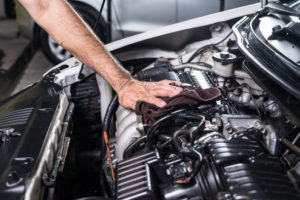
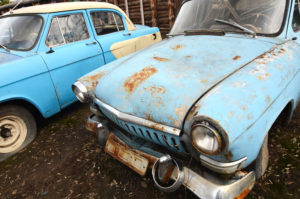 During cold weather and snow, salt is added to the roads to help prevent freezing and ice. While this makes roads safer to drive in the short term, salt can corrode the undercarriage of your vehicle. Corrosion takes time to cause significant damage, but when it does happen, it can lead to expensive repairs. Having regular car washes can help prevent the buildup of salt so you can avoid corrosion down the road.
During cold weather and snow, salt is added to the roads to help prevent freezing and ice. While this makes roads safer to drive in the short term, salt can corrode the undercarriage of your vehicle. Corrosion takes time to cause significant damage, but when it does happen, it can lead to expensive repairs. Having regular car washes can help prevent the buildup of salt so you can avoid corrosion down the road. Regularly replacing your vehicle’s fluids is an essential part of preventive maintenance. Keeping up with this part of car ownership helps prolong your vehicle’s life. Spring is the perfect time to check your vehicle’s fluids.
Regularly replacing your vehicle’s fluids is an essential part of preventive maintenance. Keeping up with this part of car ownership helps prolong your vehicle’s life. Spring is the perfect time to check your vehicle’s fluids. Don’t panic. The worst thing you can do when your brakes fail is to panic. When you panic, you are far more prone to lose control of your car and the situation, leading to a far worse outcome and possible personal injury. Whether you are stuck in traffic or driving down the highway when your brakes fail, keeping a cool head will ensure the safety of yourself and drivers around you.
Don’t panic. The worst thing you can do when your brakes fail is to panic. When you panic, you are far more prone to lose control of your car and the situation, leading to a far worse outcome and possible personal injury. Whether you are stuck in traffic or driving down the highway when your brakes fail, keeping a cool head will ensure the safety of yourself and drivers around you. A catastrophic loss of brake fluid is the most likely culprit when it comes to brake failure. In this case, the amount of pressure in the brake line is unable to engage the piston that presses against the brake pads.
A catastrophic loss of brake fluid is the most likely culprit when it comes to brake failure. In this case, the amount of pressure in the brake line is unable to engage the piston that presses against the brake pads. Delis
Delis Nuts and/or trail mix
Nuts and/or trail mix Can be Fun: If you’ve never had a picnic in your car before, why not give it a shot? Sometimes your planned trip to the park can be rained out. Or, perhaps there’s not a park nearby. With the right mentality, a picnic in your car can be a lot of fun. Grab a good friend, pack a bag (or a picnic basket if you have one), and drive to your local park for a quick nosh before enjoying a day in the sun.
Can be Fun: If you’ve never had a picnic in your car before, why not give it a shot? Sometimes your planned trip to the park can be rained out. Or, perhaps there’s not a park nearby. With the right mentality, a picnic in your car can be a lot of fun. Grab a good friend, pack a bag (or a picnic basket if you have one), and drive to your local park for a quick nosh before enjoying a day in the sun. Danger: Driving safely requires your full attention to be on the road. Multitasking on anything – whether it’s driving and being on the phone, driving and talking with your passenger, or driving and eating – reduces how much attention you have to focus on the road.
Danger: Driving safely requires your full attention to be on the road. Multitasking on anything – whether it’s driving and being on the phone, driving and talking with your passenger, or driving and eating – reduces how much attention you have to focus on the road.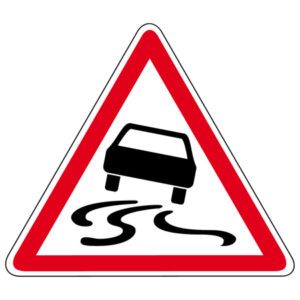 Although the name sounds silly, the term ‘fishtailing’ is a good way to think about what happens during this type of loss of control. While the car is moving, the rear end of the car slides out of alignment with the front wheels and may waver back and forth, much like a fish swimming.
Although the name sounds silly, the term ‘fishtailing’ is a good way to think about what happens during this type of loss of control. While the car is moving, the rear end of the car slides out of alignment with the front wheels and may waver back and forth, much like a fish swimming.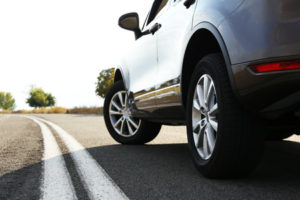 Road conditions, especially icy, snowy, wet, or slick conditions
Road conditions, especially icy, snowy, wet, or slick conditions Stay calm
Stay calm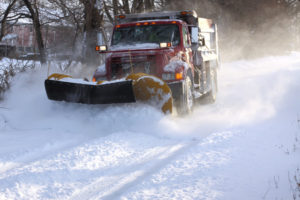 Snow plow drivers have a limited range of vision and may not see a passing vehicle
Snow plow drivers have a limited range of vision and may not see a passing vehicle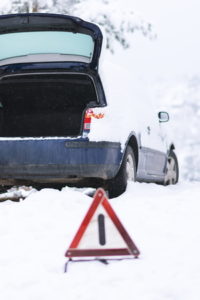 Call for assistance as soon as you can.
Call for assistance as soon as you can. Having an emergency kit in your car is invaluable when you find yourself stuck on the side of the road no matter the weather. When it comes to winter travel, however, this kit can be a lifesaver.
Having an emergency kit in your car is invaluable when you find yourself stuck on the side of the road no matter the weather. When it comes to winter travel, however, this kit can be a lifesaver.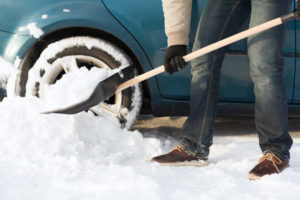
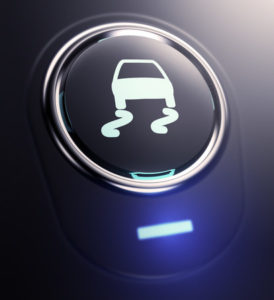 Traction control reduces the power to the wheel when the onboard computer detects slippage. In most situations, this feature can improve your overall safety by preventing the car from oversteering or going out of control. In snow, on the other hand, you’ll usually need that extra boost to get out of a snow drift.
Traction control reduces the power to the wheel when the onboard computer detects slippage. In most situations, this feature can improve your overall safety by preventing the car from oversteering or going out of control. In snow, on the other hand, you’ll usually need that extra boost to get out of a snow drift.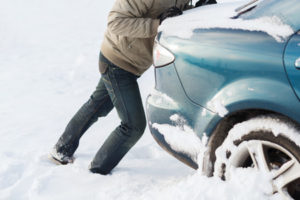 If you’re having a really difficult time getting your car out of the snow, consider sprinkling an abrasive substance like cat litter, sand, salt, or gravel in front of the tires. If ice has accumulated on your car or tires, you could even sprinkle broken up ice to improve traction for your tires.
If you’re having a really difficult time getting your car out of the snow, consider sprinkling an abrasive substance like cat litter, sand, salt, or gravel in front of the tires. If ice has accumulated on your car or tires, you could even sprinkle broken up ice to improve traction for your tires.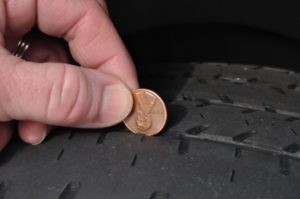 When the thermometer starts to dip towards the freezing line, it’s a good time to check on your tires.
When the thermometer starts to dip towards the freezing line, it’s a good time to check on your tires. When visibility is poor and conditions are slick, it’s usually a good idea to slow down and exercise more caution. Use your best judgment and stay safe during inclement weather!
When visibility is poor and conditions are slick, it’s usually a good idea to slow down and exercise more caution. Use your best judgment and stay safe during inclement weather! Keeping your gas tank above the half full mark has a few different benefits. For one, you can prevent long term damage to your vehicle. Condensation collects in the gas tank during colder temperatures and may lead to rusting. However, if your gas tank is at least half full, the gasoline itself absorbs any excess moisture and prevents this problem from developing.
Keeping your gas tank above the half full mark has a few different benefits. For one, you can prevent long term damage to your vehicle. Condensation collects in the gas tank during colder temperatures and may lead to rusting. However, if your gas tank is at least half full, the gasoline itself absorbs any excess moisture and prevents this problem from developing.
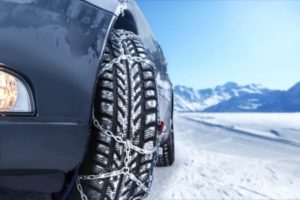 If you aren’t planning on driving in snowy weather regularly, such as if you are traveling through the mountains or a snowy region to your destination, tire chains are easy to put on.
If you aren’t planning on driving in snowy weather regularly, such as if you are traveling through the mountains or a snowy region to your destination, tire chains are easy to put on.








